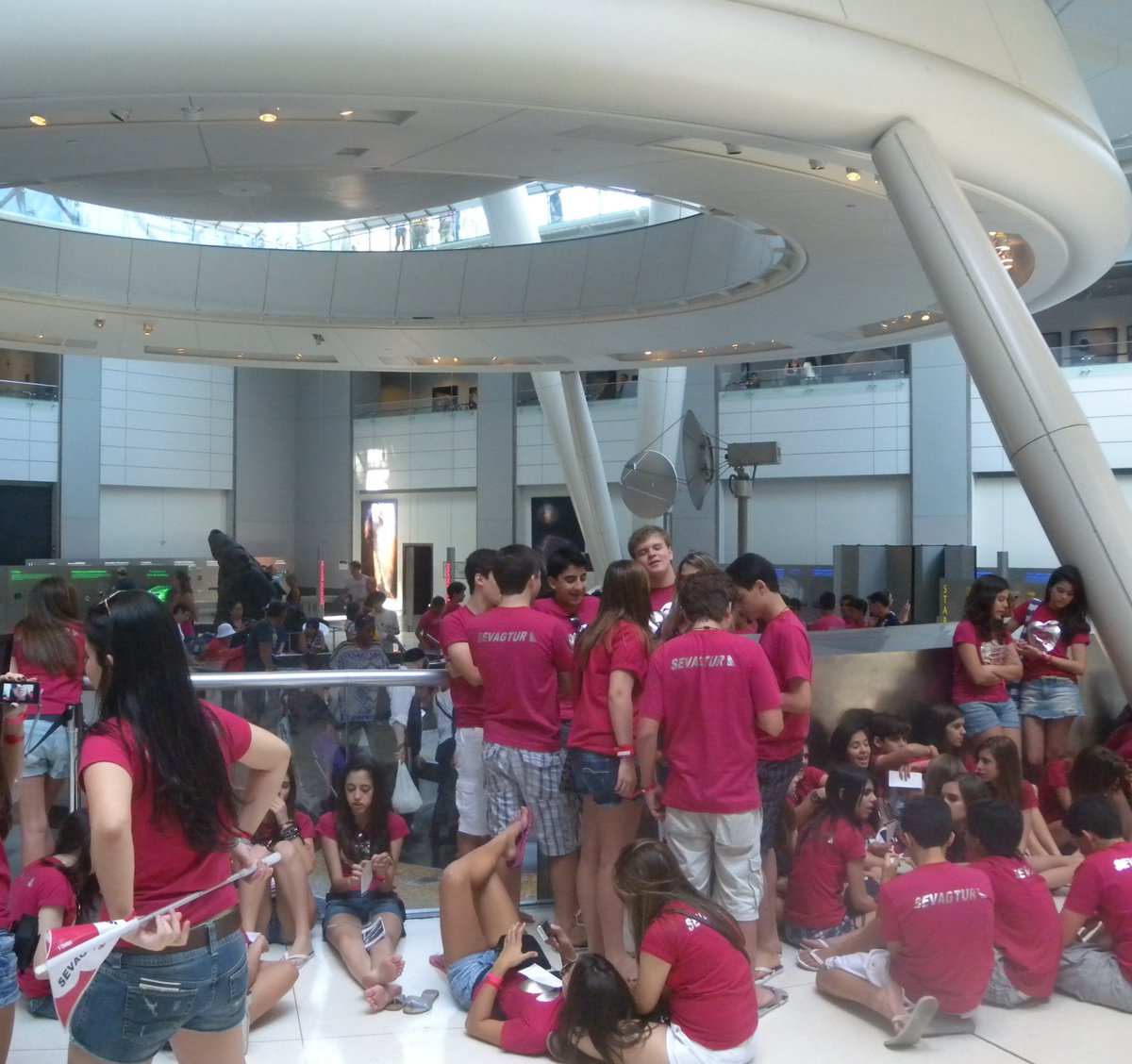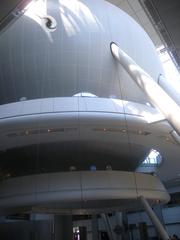
Rose Center for Earth and Space: Visiting Hours, Tickets, and New York City Historical Sites Guide
Date: 14/06/2025
Introduction
Set within the American Museum of Natural History (AMNH) in New York City, the Rose Center for Earth and Space is a world-renowned destination for astronomy and science enthusiasts. Known for its striking glass cube and the iconic 87-foot Hayden Sphere, the center fuses contemporary architecture with immersive education and interactive exhibits. Since opening in 2000, the Rose Center has evolved from the historic Hayden Planetarium into a leading hub for public science engagement under the vision of director Neil deGrasse Tyson. Visitors can expect dynamic planetarium shows, hands-on displays, and opportunities to engage with cutting-edge astrophysics research, all within an architectural marvel that inspires awe and curiosity (Philanthropy Roundtable; ArchDaily; Official AMNH Website).
This comprehensive guide covers everything you need to know about visiting the Rose Center, from history and architecture to practical information, travel tips, and nearby attractions.
Table of Contents
- Overview
- Historical Background and Leadership
- Visiting Hours and Tickets
- Accessibility and Visitor Services
- Special Events and Guided Tours
- Travel Tips and Nearby Attractions
- Visuals and Media
- FAQ
- Educational and Cultural Significance
- Exhibits and Attractions
- Architectural Vision and Design Philosophy
- Practical Visitor Tips
- Educational Impact and Learning Opportunities
- Cultural Significance and Influence
- Plan Your Visit
- References
Overview
The Rose Center for Earth and Space, integrated within AMNH, serves as a top destination for those passionate about astronomy, earth sciences, or architectural innovation. Through a blend of research, education, and design, the Rose Center inspires visitors of all ages.
Historical Background and Leadership
Origins and Evolution
The Rose Center carries on the legacy of the Hayden Planetarium, which first opened in 1935 and set a standard for public astronomy education. By the 1990s, declining attendance prompted plans for a dramatic revitalization. Originally slated for a $15 million renovation, the project expanded into a $210 million transformation, led by philanthropist Richard Gilder (Philanthropy Roundtable).
Philanthropic Legacy
Frederick Phineas Rose and Sandra Priest Rose’s landmark $20 million donation, alongside Richard Gilder’s advocacy, was pivotal in shaping the center’s ambitious vision (Paul Piazza Architect).
Architectural Innovation
James Polshek and Todd H. Schliemann of Polshek Partnership Architects—now Ennead Architects—conceived the design, with exhibition expertise from Ralph Appelbaum Associates. Their six-story glass cube, housing the Hayden Sphere, was envisioned as a “cosmic cathedral,” symbolizing transparency and wonder (ArchDaily).
Grand Opening and Technology
The original Hayden Planetarium closed in 1997. The Rose Center debuted in February 2000, equipped with the Zeiss Mark IX projector and a digital dome system for real-time universe visualization (Vacatis).
Leadership: Neil deGrasse Tyson
Astrophysicist Neil deGrasse Tyson was appointed as the Rose Center’s inaugural director, steering its educational mission and public programming. His leadership famously ignited public debate when Pluto was excluded from the center’s solar system model (Paul Piazza Architect).
Department of Astrophysics
The center houses AMNH’s Department of Astrophysics, advancing both research and public education.
Visiting Hours and Tickets
- Hours: Daily, 10:00 AM – 5:45 PM (last entry 45 minutes before closing). Confirm holiday or special event hours on the official website.
- Tickets: General admission is $23 (adult), $18 (senior 60+), $13 (child 2-12). Admission includes the Rose Center and other AMNH exhibits. Special planetarium shows may require an added fee. Advance online purchase is strongly recommended.
Accessibility and Visitor Services
- Fully wheelchair accessible entrances, restrooms, and elevators
- Assistive listening devices for planetarium shows
- Family amenities, including stroller rentals
- Guided tours and educational programs available upon request
Special Events and Guided Tours
Seasonal events, lectures, and evening stargazing programs are regularly hosted. Guided tours provide deeper insight into exhibits and astrophysical research.
Travel Tips and Nearby Attractions
- Location: Central Park West at 79th Street, Manhattan
- Public Transit: Subway (B, C lines to 81st Street–Museum of Natural History), and multiple bus routes
- Nearby Sites: Central Park, Metropolitan Museum of Art, Guggenheim Museum
- Photography: The illuminated glass cube and Hayden Sphere are especially photogenic at dusk
Visuals and Media
Experience virtual tours and high-resolution images on the official Rose Center website. Attend digital dome shows for a truly immersive experience.
Frequently Asked Questions (FAQ)
Q: Is Rose Center admission separate from AMNH?
A: No, it’s included with general museum admission.
Q: Can I take photos inside?
A: Yes, personal photography is permitted except during shows (no flash or tripods).
Q: Are there dining options?
A: Yes, museum cafes and nearby restaurants along Central Park West and Columbus Avenue.
Q: Can I book private events?
A: Yes, contact museum event services for details.
Educational and Cultural Significance
Educational Impact
The Rose Center is lauded for making complex science accessible. The Hayden Planetarium’s state-of-the-art digital projection system and Zeiss Mk IX Star Projector deliver immersive journeys through space, with shows narrated by cultural icons like Tom Hanks and Maya Angelou (Official AMNH Website). Interactive exhibits in the Cullman Hall of the Universe and the Scales of the Universe walkway foster scientific curiosity for all ages.
Programs support K-12, college, and public audiences, offering guided tours, school visits, and regular public lectures. NYC public school groups receive free admission, reinforcing the center’s educational mission (fieldtrip.com).
Cultural Landmark
The Rose Center’s architectural form—a transparent glass cube enveloping a floating sphere—reflects the ideals of scientific openness. It stands as a bold counterpoint to AMNH’s historic facades and activates the surrounding urban landscape, drawing visitors from Central Park and across the city (ArchDaily).
Through its design and programming, the center bridges art, science, and culture, enhancing New York’s reputation as a global leader in science communication.
Exhibits and Attractions
Hayden Planetarium
The heart of the Rose Center, the Hayden Planetarium, offers 360-degree, high-definition space shows utilizing real scientific data. The 2025 feature, “Encounters in the Milky Way,” is narrated by Pedro Pascal and draws on ESA’s Gaia mission data (Official AMNH Events). The Big Bang Theater at the base of the sphere provides a dramatic introduction to the universe’s origins.
Heilbrunn Cosmic Pathway
A spiraling, 360-foot walkway traces the history of the universe, contextualizing cosmic milestones and the story of life on Earth (TripExpert).
Scales of the Universe
This exhibit encircles the Hayden Sphere, comparing objects from subatomic particles to the observable universe, with models and interactive displays (WhichMuseum).
Cullman Hall of the Universe
Showcasing astrophysics and planetary science, Cullman Hall features meteorites, interactive displays, and educational programs (Official AMNH Website).
Arthur Ross Terrace
A 47,000-square-foot rooftop plaza with astronomical motifs, offering outdoor learning spaces and city views (Official AMNH Website).
Special Exhibitions and Events
The center hosts rotating special exhibitions, lectures, and workshops. Check the event calendar for current offerings.
Architectural Vision and Design Philosophy
The Rose Center is a paradigm of late 20th-century innovation, conceived by James Polshek and Todd H. Schliemann. Its seven-story, 30,980-square-meter glass cube, housing the 27-meter Hayden Sphere, symbolizes humanity’s quest for cosmic understanding (Architectuul).
Structural Innovations:
The curtain wall system uses “water white” glass for clarity, with the sphere suspended via concealed steel trusses. Integrated lighting, climate control, and acoustics ensure both preservation and visitor comfort (Architectuul).
Urban Integration:
Sited at 81st Street near Central Park West, the transparent cube contrasts with historic masonry facades, restoring an underutilized park and creating a new public plaza (Ennead Architects).
Museum Integration:
The Weston Pavilion connects the Rose Center with the AMNH complex, facilitating easy navigation between exhibits (Architectuul).
Experiential Design:
Hands-on exhibits and immersive planetarium shows are woven throughout the architecture, encouraging engagement for all ages (Ennead Architects).
Practical Visitor Tips
- Best Time to Visit: Weekday mornings for fewer crowds.
- Tickets: Purchase online for convenience and to secure planetarium show times.
- Transit: Take the B or C subway to 81st Street–Museum of Natural History.
- Amenities: Restrooms, cafes, and gift shops are available. Outside food is not permitted.
- Accessibility: Fully accessible for wheelchairs and strollers; assistive listening devices and multilingual materials provided.
Plan Your Visit
- Secure your tickets at the official AMNH website.
- Review the event calendar for special shows.
- Download the Audiala app for interactive guides and personalized tips.
- Follow AMNH and the Rose Center on social media for updates.
Summary of Key Points and Final Tips
The Rose Center for Earth and Space is a vibrant intersection of science, education, and culture in New York City. Its innovative design, accessible facilities, and wide-ranging exhibits offer a unique journey from the origins of the cosmos to the forefront of astrophysical research. Integrated with the American Museum of Natural History, the center provides seamless exploration of earth and space sciences, catering to families, students, and enthusiasts alike. With accessible hours, inclusive ticketing, and a commitment to public engagement, the Rose Center remains a beacon of scientific discovery and inspiration. Plan your visit through official channels, enhance your experience with the Audiala app, and stay connected for upcoming events and programs (Official AMNH Website; Philanthropy Roundtable).
References and Further Reading
- Philanthropy Roundtable: Rose Center for Earth and Space
- ArchDaily: Rose Center for Earth and Space
- Official American Museum of Natural History Visitor Guide
- AMNH Hayden Planetarium Research Page
- WhichMuseum: Rose Center for Earth and Space Visitor Guide
- FieldTrip.com: Educational and Cultural Significance
























































































































































































































































































